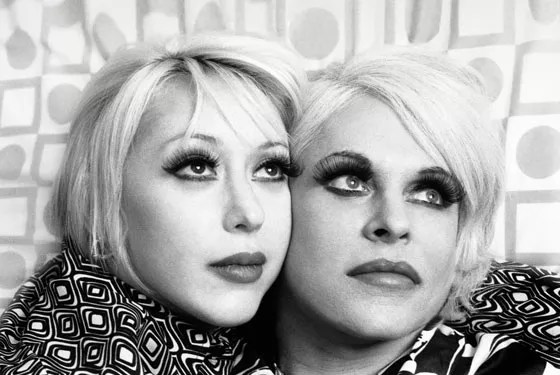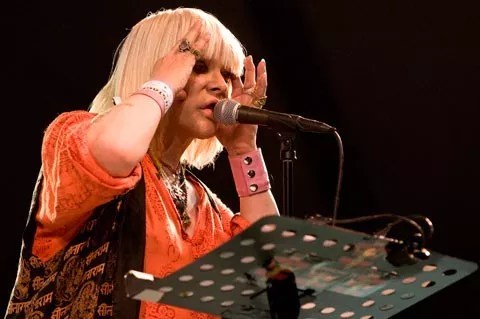
Laure Leber

Audio By Carbonatix
In death, we often talk of the body as an object, a pesky remainder left behind after the equation of life has been solved.
We call them husks, shells, meat, and empty vessels. The avant-garde polymath Brion Gysin used to compare the human body to a suitcase in his writings, something being shuttled from one mode of existence to another. The scars, tattoos, and marks we leave behind are just the travel stamps and luggage tags left behind from a lifetime of explorations. “We are here to go,” Gysin said.
Few artists internalized Gysin’s transient view on existence as deeply as his friend and disciple, the late Genesis Breyer P-Orridge. By his standards, P-Orridge lived her life with an eye toward the final departing flight, indifferent to the shape she left her luggage in after final boarding.
“The only activity worthwhile in this world: trying to unveil mysteries, and lead pleasurable, sensual, stimulating, and dangerous lives,” P-Orridge said. “There’s no other reason to be here.”
When news happens, Phoenix New Times is there —
Your support strengthens our coverage.
We’re aiming to raise $30,000 by December 31, so we can continue covering what matters most to you. If New Times matters to you, please take action and contribute today, so when news happens, our reporters can be there.
P-Orridge, who died on March 15 at the age of 70, dropped her earthly baggage after a long struggle with stage IV leukemia. She left behind a suitcase that had traveled the globe, leaving its humble point of departure in the U.K. to travel across Europe and Asia and the Americas while exploring all manners of fascinating pursuits: studying the left-hand path of Tantra in Kathmandu, engaging in sex-based performance art antics in London that got her and her collaborators dubbed “the wreckers of civilization” by the authorities, and transforming her body through decades of body modification and plastic surgery to become something akin to the divine androgyne that often appears in alchemical and Kabbalistic texts.
A fusion of male and female aspects, P-Orridge transformed her body into a mirror image of her partner Lady Jaye (who, in turn, altered herself to match P-Orridge). Some just leave one body behind after death, but P-Orridge left behind two. The second, her extensive body of work, has traveled even farther and wider than P-Orridge herself.
P-Orridge first came to prominence as part of COUM Transmissions, a performance art group in England. Working alongside a talented cabal of artists that included Cosey Fanni Tutti, Chris Carter, and Peter “Sleazy” Christopherson, they formed the granddaddy of all industrial and noise bands: Throbbing Gristle. P-Orridge was also an active participant in the mail art scene around this time, which put her in touch with important figures like William S. Burroughs, Gysin, and experimental musician Monte Cazazza.
With their mix of violent, sensationalist imagery, militant outfits, and extremely harsh sound, Throbbing Gristle (TG for short) laid out a blueprint for generations of aggressive underground artists to follow. On the band’s landmark third album, 1979’s 20 Jazz Funk Greats, they expanded their sonic palette by adding proto-New Wave songs like “Hot on the Heels of Love” and even some elements of exotica. There weren’t many other bands willing to cite both Charles Manson and “Quiet Village” maestro Martin Denny as influences.
Almost as important as their music was the band’s talent for signal-boosting. They were a potent gateway drug into a netherworld of occultism, S&M, and avant-garde traditions like Dada and Fluxus and Viennese Actionists. Never one to turn down an interview, P-Orridge’s extensive essays and conversations in seminal publications like RE/Search and Rapid Eye left behind a trail of references that led curious readers through a secret history of underground art, music, and religion.

Throbbing Gristle’s Genesis P-Orridge at Coachella in 2009.
Timothy Norris
That desire to evangelize had the unfortunate sid -effect of making P-Orridge seem like Throbbing Gristle’s sole mastermind, a misconception that the narcissistic singer was in no hurry to correct. Minimizing the efforts of her collaborators was a bad habit that would persist throughout the rest of her life.
Even more disturbing is the very credible-sounding allegations of physical and psychological abuse Tutti (who dated her bandmate throughout much of the TG years) leveled against P-Orridge in her 2017 autobiography. Any attempt to credit her as the prime mover behind TG falls apart when you look at the fantastic work Christopherson, Tutti, and Carter did post-TG as (respectively) Coil and Chris & Cosey.
Following the collapse of TG, P-Orridge would form a new group with Alex Fergusson called Psychic TV. While they were more of an accessible outfit, the band fed into P-Orridge’s most ambitious post-Gristle project: organizing an occultist organization called Thee Temple Ov Psychick Youth. Thee Temple and its distinct three-line cross logo would go on to cast a long shadow over the underground as a laboratory for developing weird new metaphysical ideas, art projects, and popularizing the sigil magick techniques of Austin Osman Spare for a whole new generation.
The intertwined relationship between Psychic TV and the Temple became another organizational model for subcultural groups to follow: a way to appropriate the mysticism and communal lifestyle of the hippie culture while giving it a dark, kinkier edge. The hippies had “Turn on, tune in, drop out;” the TOPY collective had “See a cliff, jump off.”
“My entire life has been about goading, prodding, and exposing the pus-filled underbelly of the established social status quo,” P-Orridge said. “I’ve always seen it as my natural prey and target. I feel like that is why I was sent here, merely to be a thorn in the side of the great big sow of capitalism.”
The problem with being the thorn in anything’s side is occasionally you get plucked out. P-Orridge fell afoul of a “Satanic panic” witch hunt and had to stay out of her home country for years after English police seized her home and personal collection after a tabloid documentary claimed to have found videos of P-Orridge sexually abusing children in a ritual setting. The videos in question didn’t involve P-Orridge or any children at all. They were a fictional film shot by Christopherson. It didn’t matter in the eyes of the great big sow. P-Orridge had become an orphan to Mother England.
P-Orridge would go on to record more Psychic TV albums in the States (and also release a few spoken word albums as Thee Majesty), and would later meet Lady Jaye and embark together on their ambitious “Pandrogyne” body modification project until Jaye left her suitcase behind in 2007. By this point, P-Orridge had assumed the position her beloved mentor Burroughs once held: elder statesman/shaman of the freak underground.
Without the pioneering influence of P-Orridge and her numerous projects, we wouldn’t have the vibrant industrial and noise scenes we have now. Grant Morrison probably wouldn’t be writing brilliantly insane comic books.
Even in the local Arizona scene, you can see her enduring influence in scenes like the Ascetic House community and their love of mixing occultist imagery and trickster-obfuscation with uncompromising noise assaults and mysterious sonics. P-Orridge laid out a road map for generations of thorns to follow as they move up and down the great sow’s body.
“People’s lives should be as interesting as their art,” P-Orridge said. Mission accomplished.